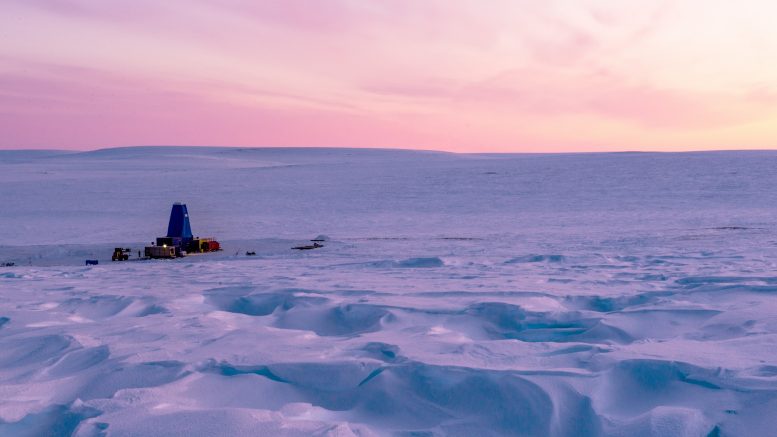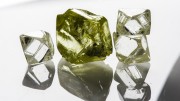In 2013, De Beers Canada turned down a chance to own a majority stake in Peregrine Diamonds’ Chidliak project in Nunavut.
Five years later, it now owns the project outright.
What changed in that time period? De Beers Canada CEO Kim Truter says that the timing just wasn’t quite right the first time around.
“I always say to people that to develop a mining business, you need a few stars to line up and of course the number one star is what’s happening with the global economy and what’s happening with the diamond business in general, then you get down to the local environment and the quality of the asset. At that time, those various stars just didn’t line up,” Truter told Diamonds in Canada magazine in an October interview.
Now, the situation on all those fronts is different.
“First of all, the project had actually advanced, so credit to the Peregrine team that have done a tremendous job advancing the understanding of the orebodies and the kimberlite pipes up there,” Truter explains. “That, coupled with our portfolio needs and where the economy was sitting meant the stars did line up. So it’s fantastic to have made that acquisition.”
With its Snap Lake mine on care and maintenance since the end of 2015 and its Victor mine to close next year, it was vital for De Beers — which has been in Canada for 50 years — to get new projects in its pipeline to complement production from its 51%-owned Gahcho Kué mine.
And whereas its past joint venture option on Chidliak would have given it 50.1% of the asset for a total investment of $58.5 million, it acquired Peregrine and all its Canadian projects in a friendly deal in September for 24¢ a share or $107 million.
But most importantly, perhaps, is that Chidliak — if proven economic — presents the perfect opportunity for De Beers to put into action the “FutureSmart” approach to mining innovation being developed by Anglo American (LSE: AAL), De Beers’ parent company. (Anglo owns 85% of De Beers with the government of Botswana owning 15%.)
“From an Anglo American point of view, we would like to improve our mining image. The world is moving on and expectations about what a mining project looks like and the impact on the environment and communities is evolving,” Truter said.
“It’s very important to us that we now start setting ourselves apart by building mines that have a much smaller footprint and embrace some of the technologies that either currently exist or are emerging so we can change how we operate, we can change our footprint on the environment, we can offer a different value proposition for communities and government, and we can offer a different value proposition for employees, including things like working remotely.”
The company will also be working to reduce its energy footprint at its projects, and will look to work with government and local communities on joint infrastructure needs — whether energy or data transmission requirements, Truter said.
Peregrine released an updated positive PEA looking at development of the CH-6 and CH-7 kimberlites — two of the 74 kimberlites at Chidliak — in May. The study showed current resources at the two kimberlites could support a mine producing 16.7 million carats over a 13-year mine life.
But using innovative technologies and approaches, De Beers is hoping to develop more of the kimberlites while leaving a much smaller footprint. While De Beers has employed innovative technologies at many of its mines, including Gahcho Kué, Chidliak would be the first of its mines globally to incorporate FutureSmart innovations.
“For us to have sole ownership of those 74 kimberlite pipes gives us a very good opportunity to find the model where we can try to develop as many of those pipes as possible,” Truter says. “That will take some different thinking as we think about things like a mining method that is scalable and reproducible and something we can potentially move from one pipe to the next.”
A lean, precision approach would be completely different from a traditional mine like Gahcho Kué, which is a sprawling mining complex with lots of physical infrastructure on the ground.
“We want to avoid that up on Baffin Island — somehow find a way of mining pipes with a very, very small footprint and something that allows us to move from one pipe to the next without leaving much infrastructure behind.”
But first, De Beers needs to prove the economics of the project, and get through the permitting process. Over the next two to three years, the company will be advancing permitting, as well as environmental, traditional knowledge, and technical studies at Chidliak.
Chidliak isn’t De Beers Canada’s only new holding.
The company is also providing services and support to Adia Resources in return for a 15.4% stake.
A private company majority owned by Altius Minerals (TSX:ALS), Adia has an option to earn a 100% interest in the Lynx diamond project in northeast Manitoba, where a 15.8-km sample taken in 2016 returned 144 microdiamonds.
Truter also says the company is looking in Ontario, near Victor — which has been a “very consistent” mine, and where about 30% of land reclamation for closure has already been completed — as well as elsewhere in the province and across the country.
Gahcho Kué
Since starting commercial production in March 2017, Truter says that Gahcho Kué, in the Northwest Territories, has performed well.
“First of all, the ramp-up went exceptionally well. To go from standing position to full production within a year — and actually better than full production as we’re exceeding the design capacity of the process plant and we’re recovering a lot more diamonds than we anticipated — it’s been a success story to date.”
Truter says De Beers, which operates the mine, has tested some new and innovative concepts at the open-pit mine, including alternative energy and running a lean operation with a compact workforce. Another example is pit sequencing. As a new open pit is mined, the waste material will go into the first pit, and so on. “In other words, we’re filling the first hole with the second hole — so that’s quite innovative and hasn’t been tried elsewhere.”
Prices for Gahcho Kué diamonds have been lower than expected (JV partner Mountain Province Diamonds [TSX: MPVD; NASDAQ: MPVD] has reported recent sales at between US$60 and US$99 per carat, as opposed to revenue of US$149.66 per carat projected in its 2014 feasibility study).
However, Truter says the higher than expected grades and volume have balanced out any price weakness.
“Whenever you conduct a feasibility study, there are always going to be pluses and minuses. We’ve experienced both — we’re getting better grades and more volume from the pipes, but some of the prices are a little bit lower.”
One recent plus for the property has been the discovery of new kimberlite between the Tesla and Tuzo kimberlites, and between the 5034 and Tuzo kimberlites. With its partner, Mountain Province Diamonds, De Beers will be working into mid-2019 to bring the new kimberlite into the mine plan with additional drilling and technical studies.
“There is some potential that this might extend the life of the asset, and we’re obviously hopeful of that,” Truter says. “And it won’t be the end of the story because we’ll keep drilling. We have some theories about the size and extent of the kimberlite orebodies and if they continue to grow, that again might lengthen the life of the asset — so that’s all positive upside.”
— This article was first published in the November 2018 issue of Diamonds in Canada.




Be the first to comment on "De Beers looks to push the innovation bar at Chidliak"